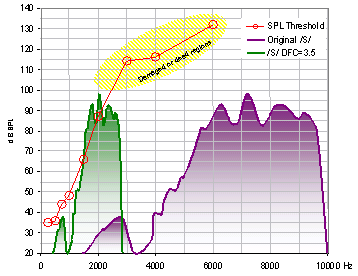Question
What is frequency compression, and please give an example?
Answer
To detect and discriminate (recognize) high frequency voiceless sounds, it is necessary to have access to the entire bandwidth of these sounds.
A candidate for frequency compression technology typically has better residual hearing in low frequencies and limited or no usable hearing in higher frequencies, i.e. a reduced bandwidth of useable hearing, with the best hearing being located in lower frequencies.
Therefore, it is important to squeeze the entire spectrum of the voiceless sounds into the client's limited bandwidth of audibility (lower frequencies).
The graph below illustrates this concept. A linear frequency scale is used to show the true proportion of Frequency Compression:
Thresholds in HL are listed below.

The red curve on the graph shows hearing thresholds converted to SPL.
Note that hearing above 2KHz is severely damaged. Cochlear dead regions are suspected.
The purple curve illustrates the spectrum of a typical /s/ sound amplified by approximately 40dB. This example is hypothetical as hearing aids are unable to amplify this much at 6-8KHz.
Even with this unrealistic amount of gain, the energy peaks of the /s/ sound are considerably below the thresholds.
The green curve shows the /s/ sound after processing with Digital Frequency Compression (DFC) by a factor of 3.5. Note that the two primary energy peaks of the "compressed" /s/ are above the thresholds and located at the more usable region, 1-2KHz.

Wendy Davis has been an audiologist for 15 years. She practiced as a clinical audiologist and educational audiologist for 6 years before joing Sonovation/AVR in 1994. Ms. Davis is involved in research and product development as well as training and clinical support for Sonovation/AVR. She can be reached at wedavis@avrsono.com.
To visit the Sonovation website, click here.